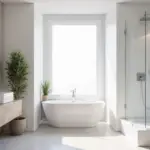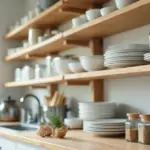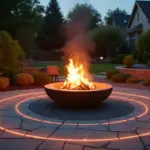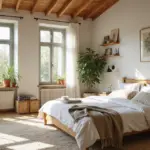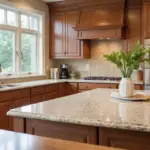Is your kitchen feeling a little cold and sterile? Do you dream of a space that wraps you in warmth and comfort the moment you step inside? Look no further than the rich, inviting tones of brown!
Often overlooked in favor of cooler greys and stark whites, brown is making a stylish comeback in kitchen design, bringing with it an unparalleled sense of coziness and sophistication. From deep chocolate hues to light, earthy tones, brown offers a versatile palette that can be adapted to suit any style, from rustic farmhouse to sleek contemporary.
Ready to discover the transformative power of brown kitchen inspiration? Let’s dive into 18 inspiring ideas to infuse your kitchen with warmth and character.
1. Rich Chocolate Cabinets: Indulge in Deep Brown Hues for a Luxurious Feel
Chocolate brown cabinets exude luxury and sophistication unlike lighter shades. The beauty lies in their ability to bring depth and warmth that creates an elegant atmosphere, adding drama while remaining practical. Dark cabinets cleverly conceal everyday smudges, meaning less cleaning and more enjoying. The striking contrast achieved by pairing these cabinets with lighter countertops and metallic hardware creates a truly captivating space.

Choosing the right countertops is key. For classic brightness, consider white marble, cream quartz, or light granite to offset the darkness and brighten the kitchen. For bold drama, explore black granite or soapstone for a seamless, sophisticated look. Wood countertops in lighter shades like maple or butcher block introduce warmth and inviting contrast. Always consider your cabinet undertones when selecting countertops to ensure a harmonious palette.
Here’s the inside story – brass or gold hardware enhances the luxurious feel, while chocolate brown psychologically evokes comfort and security. Before committing, paint a sample on plywood and observe it under different lighting conditions to ensure it complements your space.
The heart of the matter is finding the right balance of rich color and complementary elements. Now, let’s move from the indulgence of chocolate to another way to anchor your brown kitchen design with a welcoming oak island.
2. Warm Oak Islands: Anchor Your Kitchen with a Welcoming Brown Centerpiece
A warm oak island beautifully blends practicality with aesthetic appeal, making it an ideal central feature. The natural grain and inviting warm tones create an immediate sense of comfort and grounding. Beyond looking gorgeous, these islands provide invaluable workspace, storage, and often become the heart of the home – where family and friends naturally gather. Oak’s durability ensures it can withstand daily kitchen battles, while its timeless quality guarantees relevance for years to come.

When selecting your oak island, several design elements need careful consideration. Size and proportions must suit your kitchen dimensions – too large feels cramped, too small lacks functionality. Consider your existing cabinets and countertops for cohesive design. Think about the island’s primary function (prep space, dining, storage) to determine the best storage solutions and countertop material. Don’t forget lighting! Pendant lights or strategically placed recessed lighting effectively highlight the island, transforming it into a true focal point.
What many people overlook is how a butcher block section can add rustic functionality, or how oak’s exceptional durability makes it perfect for heavy-use areas. If budget’s tight, oak veneer provides similar aesthetics at lower cost.
Let’s shift our focus upwards from the central island to another surface that can bring brown warmth into your kitchen: the natural beauty of walnut countertops.
3. Walnut Countertops: Embrace the Natural Beauty of Dark Brown Wood Surfaces
Walnut countertops offer a unique and sophisticated choice that combines beauty with functionality. Their rich, dark brown color and distinctive grain patterns immediately add warmth and elegance to any kitchen. Walnut is relatively hard, providing good durability, and surprisingly water-resistant when properly sealed. It’s also a sustainable choice when responsibly sourced, transforming into a focal point that effortlessly elevates your kitchen’s design.

Maintaining walnut’s beauty requires proper care. Clean with a damp cloth and mild soap, avoiding abrasive cleaners or harsh chemicals. Wipe up spills immediately, especially acidic substances that can stain or etch. Periodic oiling with food-safe mineral oil or butcher block conditioner keeps the wood hydrated, preventing cracks and maintaining luster. For enhanced protection, apply a wood-specific sealant. Always use cutting boards and avoid placing hot items directly on the surface.
Picture it this way: walnut countertops paired with light cabinetry create striking contrast, while the wood naturally darkens over time, developing a richer patina. Apply food-safe sealant every 6-12 months for protection against water damage and stains.
From the sleek elegance of walnut countertops, let’s move to the backsplash and explore how terracotta tiles can bring a rustic, earthy brown element to your kitchen.
4. Terracotta Tile Backsplash: Inject Rustic Charm with Earthy Brown Tones
Terracotta tile offers a unique combination of rustic charm, inherent warmth, and surprising durability. Its earthy brown tones immediately create a welcoming atmosphere, complementing styles from cozy farmhouse to Mediterranean. Though naturally porous, when properly sealed, terracotta becomes durable and relatively low-maintenance. The inherent variations in color and texture add character and visual interest, ensuring each backsplash is beautifully unique.

Terracotta’s versatility shines across various design styles. Farmhouse kitchens benefit from its rustic, natural aesthetic. Mediterranean-inspired spaces find authenticity in terracotta’s warm, earthy tones. Even modern kitchens can incorporate terracotta for warmth and texture, creating intriguing contrast with sleek lines. Pair with natural wood cabinets, stone countertops, and copper accents to enhance the rustic, earthy aesthetic.
The surprising part is how different sizes and shapes of terracotta tiles can create unique patterns for your backsplash. Remember that “terracotta” means “baked earth” in Italian, and always seal tiles after installation to protect from stains and moisture.
Moving from the backsplash down to the floor, let’s explore how natural wood flooring can ground your brown kitchen inspiration in organic warmth and texture.
5. Natural Wood Flooring: Ground Your Brown Kitchen in Organic Warmth and Texture
The ideal wood flooring for a brown kitchen depends on your specific brown shade and desired aesthetic. Lighter woods like maple, birch, or ash create refreshing contrast against darker cabinets, brightening the space. Medium-toned woods such as oak or hickory offer versatile options that complement various brown shades. For luxury and depth, consider darker woods like walnut or cherry. Don’t forget to consider grain patterns – prominent grains add rustic charm, while finer grains offer sophistication. Always check the Janka hardness rating to ensure durability for your kitchen traffic.

Wood flooring brings both warmth and texture to a brown kitchen. Natural variations in color, grain, and knots create visual interest, preventing the room from feeling flat. The tactile feel underfoot adds comfort and connection to nature. When paired with brown cabinets and countertops, wood flooring amplifies the kitchen’s earthiness and coziness. Texture can be enhanced with brushed or hand-scraped finishes for additional rustic charm and depth.
This is where everything changes – incorporate a patterned wood floor like herringbone or chevron for sophisticated visual interest. Before installation, allow the wood to acclimate to your kitchen’s temperature and humidity for several days to prevent warping.
Now let’s shift our focus from the floor to the finer details, specifically how bronze hardware accents can add metallic sparkle to your brown cabinetry.
6. Bronze Hardware Accents: Add a Touch of Metallic Sparkle to Brown Cabinetry
Bronze hardware provides a beautiful blend of contrast and complementary warmth to brown cabinetry. Its metallic sheen catches light, adding crucial visual interest and preventing brown from appearing flat. Bronze offers remarkable range – from bright, polished sheen for glamour to muted, antique looks for vintage charm – allowing you to perfectly match your cabinet shade and kitchen style.

Bronze hardware comes in various styles, from classic knobs to sleek pulls, elegant handles, and decorative hinges. For lighter brown cabinets, consider polished or brushed bronze for a contemporary, luminous feel. Darker cabinets pair beautifully with antique or oil-rubbed bronze, enhancing depth and sophistication. Always consider your overall kitchen style – Shaker cabinets work with clean-lined pulls, while ornate cabinets can handle decorative hardware for traditional luxury.
The breakthrough came when designers started mixing hardware styles – using knobs on upper cabinets and pulls on lower cabinets creates visual interest. Bronze’s natural antimicrobial properties make it hygienic for kitchen use. Before purchasing, order samples to see how they look against your specific cabinet color in your kitchen’s lighting.
From hardware, let’s move to open shelving and explore how wooden shelves can display natural décor against a brown kitchen backdrop.
7. Wooden Open Shelving: Display Natural Decor Against a Brown Kitchen Backdrop
When choosing wood for open shelving in a brown kitchen, consider your overall tone. For lighter brown kitchens, warmer woods like oak, cherry, or walnut offer enriching contrast and depth. In darker brown kitchens, lighter woods such as maple or birch brighten the space and prevent heaviness. Reclaimed wood adds unique character and rustic texture regardless of your brown shade. Always properly seal your shelves to protect from moisture and kitchen grime.

Natural elements are key when styling wooden shelves in a brown kitchen. Incorporate greenery like potted herbs or trailing plants to bring life and freshness. Ceramic or stoneware in earthy tones (cream, beige, terracotta) echo the natural palette. Woven baskets, wooden bowls, and clear glass jars with dried goods add texture and function. Metallic accents like copper pots or brass candlesticks provide elegance and warmth. Choose items that either complement your existing brown palette or provide intentional contrast to prevent visual monotony.
Let me show you another perspective: create a dedicated coffee station on your open shelving, displaying mugs, beans, and a French press. Open shelving makes small kitchens feel larger by removing the visual barrier of upper cabinets. Before installing, check weight limitations and mount securely to studs, especially for heavier items.
From open shelving, let’s move to a classic color palette, exploring how a brown and white combination achieves timeless elegance in your kitchen.
8. Classic Brown and White Palette: Achieve Timeless Elegance with a Balanced Duo
The combination of brown and white in kitchen design is considered a classic for good reason. White provides brightness, airiness, and cleanliness, creating an open feel. Brown adds warmth, earthiness, and sophistication, grounding the space. This balance creates a kitchen that’s both elegant and welcoming, transcending trends. The contrast between colors is visually appealing and allows for easy customization through accents and textures. Brown and white work seamlessly with various kitchen styles, from traditional to contemporary.

Balancing brown and white effectively requires consideration of tone, texture, and proportion. To prevent starkness, choose warm browns like rich walnut or cherry, paired with softer whites like ivory instead of pure white. Introduce textures through natural wood grain, stone countertops with veining, or woven baskets. Use brown as a deliberate accent through a striking island, rich lower cabinets with white uppers, or brown shelving against white walls. Add color pops through artwork, cookware, or patterned backsplash to inject personality. Vary brown and white shades for a layered, rich look. Consider the 60-30-10 rule: approximately 60% white, 30% brown, and 10% accent color.
Do you see how huge that is? Try white shaker cabinets with a dark brown kitchen island focal point. Brown psychologically evokes stability and comfort – perfect for the heart of your home. Start with larger elements (cabinets, countertops) to choose your brown and white shades, then select smaller details to complement the scheme.
Moving away from the classic duo, let’s bring in another color and explore the refreshing vibe of earthy brown and green combinations in the kitchen.
9. Earthy Brown and Green Combinations: Bring Nature Indoors for a Refreshing Vibe
Brown and green together create an inherent connection to the natural world, evoking tranquility, growth, and well-being. Brown provides a solid, grounding base reminiscent of soil and tree trunks. Green introduces freshness, vitality, and life, like vibrant foliage. This natural pairing creates balance and harmony, subtly reminding us of the outdoors while promoting calm in what’s often a high-traffic, potentially stressful area of the home.

The best combinations depend on your desired mood. For warm invitation, pair rich chocolate browns with soft olive or muted sage greens, creating cozy sophistication. For contemporary vibrancy, try lighter beige browns with bold emerald or muted teal. Deep forest greens with dark walnut create drama and luxury. Consider undertones when selecting – warm browns (reddish/yellowish undertones) generally pair best with warm greens, while cooler browns (greyish/bluish undertones) complement cooler greens for harmony.
The game-changer happened as I incorporated a green subway tile backsplash with brown grout for a rustic yet modern feel. Green psychologically represents health and renewal – beneficial qualities for a kitchen. Start with a neutral brown base for cabinets or walls, then introduce green through accessories, plants, or backsplash for easy future updates.
From refreshing greens, let’s transition to calming blues, and explore serene brown and blue hues to create a coastal-inspired kitchen.
10. Serene Brown and Blue Hues: Create a Calming Coastal-Inspired Kitchen Space
Brown and blue create a naturally beautiful contrast that evokes calm and relaxation, reminiscent of beach and ocean. Brown represents earth through wood, sand, and natural textures. Blue represents sea and sky, bringing airiness and refreshment. The combination is inherently balanced and inviting. Lighter browns mimic driftwood and sandy beaches for airy coastal aesthetics, while deeper browns provide grounding warmth and stability. Blue adds the essential refreshing feel crucial for capturing coastal essence.

For a light, airy coastal feel, pair light browns (soft beige, warm sand, weathered driftwood) with pastel blues, gentle sky blue, or soft seafoam green. These lighter combinations create bright, breezy atmospheres. For dramatic sophistication, combine darker browns like rich chocolate or deep walnut with navy blue or vibrant teal. Consider using a gradient of blues to mimic ocean depths, and varying brown shades from cabinets to countertops and flooring for layered richness.
Let me paint you a picture: light brown wood cabinets with a soft, muted blue island. Brown and blue together create tranquility and stability. Start with neutral brown for walls and floors, then layer in blue accents through accessories and textiles.
From calming coastal blues, let’s elevate the mood and explore luxurious brown and gold accents to add opulent details to your kitchen.
11. Luxurious Brown and Gold Accents: Elevate Your Kitchen with Opulent Details
The combination of brown and gold inherently evokes luxury due to each color’s qualities. Darker browns like espresso or mahogany provide a sophisticated, elegant base. Gold, as a precious metal color, symbolizes wealth and timeless elegance. Together, brown’s earthy warmth complements gold’s brilliance, creating appealing contrast that prevents brown from feeling heavy while adding dynamic visual interest.

Subtlety is key when incorporating gold accents for luxury without overwhelming. Consider:
- Gold hardware on cabinets and drawers – elegant knobs, sleek pulls, stylish handles
- Statement gold faucet or pot filler at the sink area
- Gold-framed artwork or decorative mirrors to reflect light
- Gold-toned pendant lights or elegant wall sconces
- Gold-leafed trim or detailing on cabinets, islands, or range hoods
- Strategic gold accessories like vases, bowls, or displayed utensils
Distribute gold accents thoughtfully throughout the kitchen for balanced, cohesive luxury rather than cluttered opulence.
The tricky part is incorporating a gold-veined marble or quartz countertop for subtle luxury. Gold has symbolized wealth for millennia across cultures. Start small by replacing cabinet hardware with gold-toned options before committing to larger changes.
Moving from overt luxury, let’s explore understated sophistication with a brown and grey blend, designing a modern and chic kitchen.
12. Sophisticated Brown and Grey Blend: Design a Modern and Chic Kitchen Aesthetic
Brown and grey offer a beautifully balanced, sophisticated aesthetic for modern kitchens. Brown brings essential warmth, earthiness, and comfort, making the space inviting. Grey introduces coolness, modernity, and refined elegance. Combined effectively, they create a space that’s both inviting and contemporary. The contrast between warm and cool adds depth and interest, preventing sterility or excessive rusticity. Their neutrality provides a versatile backdrop for colorful accessories without disrupting harmony.

Key design elements for blending brown and grey include choosing specific shades wisely. Opt for warmer browns like rich walnut or pecan paired with lighter greys like dove or greige. Consider materials carefully – natural wood cabinets in warm brown stain with sleek grey quartz countertops create textural luxury. Stainless steel appliances and hardware naturally complement both colors. Choose sophisticated glass tile backsplash in subtle grey or textured stone incorporating both tones. Consider lighting’s impact – warm lighting enhances brown’s richness, while cooler lighting highlights grey’s modernity. Balance is crucial; avoid leaning too heavily on either color.
Things took an interesting turn when designers started incorporating brown wood islands with grey concrete countertops for striking contrast. Grey has increasingly replaced stark white as the go-to neutral in kitchen design. Start with neutral grey walls and introduce brown through cabinetry and flooring.
Let’s move from color palettes to light itself, exploring sun-drenched brown kitchens and how maximizing natural light enhances warm brown tones.
13. Sun-Drenched Brown Kitchens: Maximize Natural Light to Enhance Warm Brown Tones
Natural light is crucial in a brown kitchen because it prevents the space from feeling dark or enclosed. Brown naturally absorbs rather than reflects light, potentially creating a darker ambiance. Natural light brightens the room, highlighting the richness and subtle variations in brown tones. This infusion creates warmth and invitation, making the kitchen more welcoming. Natural light also enhances textures and details, making the space feel open, airy, and visually appealing.

Several design elements can maximize natural light in a brown kitchen:
- Large Windows: Incorporate large windows or a window wall to flood the kitchen with sunlight
- Skylights: Bring light from above, especially in kitchens with limited exterior walls
- Light-Colored Countertops: Choose reflective surfaces like light granite, quartz, or glossy tile to bounce light around
- Strategic Mirrors: Place mirrors opposite or adjacent to windows to reflect and amplify light
- Open Shelving: Choose open shelving instead of solid uppers to allow light penetration
- Glass Cabinet Doors: Use glass-fronted cabinets to pass light through and create openness
- Light-Colored Walls/Ceilings: Use lighter paint colors with brown cabinets to maximize reflection
- Minimal Window Treatments: If privacy allows, minimize treatments or use sheers that filter light
Here’s where it gets interesting: install a sun tunnel to bring natural light into a windowless brown kitchen. Studies show natural light improves mood and productivity, making your kitchen more enjoyable. Assess your layout to identify areas for adding or enlarging windows or skylights, consulting contractors about feasibility.
From maximizing light, let’s move to minimizing clutter with sleek brown minimalist designs, embracing simplicity and clean lines in brown.
14. Sleek Brown Minimalist Designs: Embrace Simplicity and Clean Lines in Brown
Sleek brown minimalist kitchens prioritize functionality, visual harmony, and understated elegance. Key characteristics include handleless cabinetry in sophisticated browns (from chocolate to taupe) with matte or subtly textured finishes; integrated appliances that blend seamlessly with cabinetry; minimal ornamentation and absence of clutter; focus on natural light; durable, easy-clean materials like quartz or solid surface countertops; and carefully curated accessories that complement the minimalist aesthetic. Brown tones provide essential warmth while minimalist principles ensure spaciousness, calm, and effortless sophistication.

A monochromatic color scheme with varying brown shades adds depth to minimalist kitchens without clutter. Use dark, rich brown for lower cabinets to anchor the space, with lighter browns for upper cabinets and walls to create airiness. Introduce subtle textures through natural wood grain or patterned backsplash within the brown palette for interest without disrupting clean aesthetics. A lighter brown island can serve as a focal point, breaking cabinet uniformity. Maintain a cohesive color story throughout while introducing subtle variations in shade and texture for dimension within the minimalist framework.
The stumbling block is incorporating hidden storage. Try a concealed pantry behind seamless brown cabinet doors for maximum storage and clutter-free appearance. Brown psychologically represents stability and nature connection, making it comforting for kitchens. Choose handleless cabinets with push-to-open mechanisms for streamlined looks, ensuring hardware is concealed or matches cabinet color.
From minimalist sleekness, let’s transition to cozy rustic charm, exploring the inviting warmth of a brown farmhouse style kitchen.
15. Cozy Brown Farmhouse Style: Infuse Rustic Charm and Inviting Warmth
Key elements of a brown farmhouse kitchen embrace natural materials and rustic charm. These include natural wood tones in cabinetry, flooring, and butcher block countertops; classic shiplap walls in creamy whites or soft neutrals; quintessential apron-front sink; open shelving displaying vintage dishware or copper pots; exposed ceiling beams when possible; and maximized natural light. The color palette typically includes browns, soft creams, clean whites, and muted greens or blues. Distressed finishes and vintage-style hardware add lived-in character to the farmhouse kitchen.

To incorporate brown without darkness, balance with lighter, brighter elements. Use lighter browns and soft creams for walls and backsplash to create a bright backdrop. Maximize natural light through large windows or skylights. Add strategic lighting with charming pendants over the island and under-cabinet lighting for work areas. Use lighter countertops like white quartz or marble to contrast darker cabinets and reflect light. Introduce color pops through dishware on open shelves, vibrant textiles, and fresh plants to keep the space feeling vibrant and current.
My discovery began when I installed a reclaimed wood island with distressed brown finish as the kitchen focal point. Farmhouse kitchens prioritize functionality, reflecting working farm needs. To create distressed cabinets, lightly sand edges and corners to reveal underlying wood, then apply sealant.
From cozy farmhouse, let’s delve deeper into texture, exploring rustic brown kitchen textures by layering wood, stone, and woven elements.
16. Rustic Brown Kitchen Textures: Layer Wood, Stone, and Woven Elements for Depth
Texture is paramount in rustic brown kitchens because it adds crucial visual interest, tactile depth, and character, preventing flatness or monotony. Varying textures of wood, stone, and woven materials contribute to the warm, inviting ambiance characteristic of rustic design. These diverse textures mimic nature, reinforcing the outdoor connection central to rustic aesthetics. The interplay of rough and smooth, hard and soft creates a rich tactile experience enhancing comfort, appeal, and atmosphere.

For a textured rustic kitchen, consider specific materials:
Wood Elements:
- Reclaimed ceiling beams for architectural interest
- Butcher block countertops for warmth and practicality
- Exposed wooden shelving for display
- Shiplap walls for farmhouse charm
Stone Options:
- Natural stone backsplash (textured slate, warm travertine, river rock)
- Stone accent wall as focal point
- Durable flagstone flooring for earthy foundation
Woven Additions:
- Rattan bar stools for seating
- Wicker baskets for stylish storage
- Natural jute rug for warmth
- Woven pendant lights for textural lighting
- Soft linen curtains for window framing
You may have noticed how a reclaimed wood island with live edge creates a unique natural focal point. “Rustic” comes from Latin “rusticus,” meaning “of the country.” When layering textures, consider scale – use larger stone/wood pieces for foundation and smaller woven accents for detail.
Moving from rustic texture to modern sleekness, let’s explore streamlined brown contemporary spaces, combining functionality with modern brown finishes.
17. Streamlined Brown Contemporary Spaces: Combine Functionality with Modern Brown Finishes
Streamlined brown contemporary kitchens emphasize clean lines, minimal ornamentation, and optimal functionality. They feature flat-panel cabinetry in sophisticated browns from espresso and mahogany to walnut and oak, combined with modern materials like stainless steel, glass, and concrete. Integrated appliances and hidden storage maintain uncluttered aesthetics while enhancing functionality. The design goal is creating a sleek, efficient, practical space that’s stylishly contemporary and user-friendly.

Using varied brown shades creates depth in contemporary kitchens while maintaining streamlined aesthetics. Pair dark espresso cabinets with lighter walnut countertops and backsplash tiles in warm beige or taupe to bridge the tonal range. Subtle textures through natural wood grain or patterned backsplash add dimension without compromising clean lines. Mixing matte and glossy finishes creates subtle contrasts and light play without extraneous ornamentation, aligning with streamlined contemporary principles.
My experience went like this: I incorporated a large kitchen island with a waterfall countertop in contrasting white quartz, creating a focal point in my brown kitchen. Brown evokes warmth, stability, and comfort, making it popular for kitchens. Choose flat-panel cabinetry with simple, handleless design and push-to-open mechanisms for cleaner aesthetics.
Finally, let’s add some excitement and explore brown kitchens with vibrant pops of color, brightening the space with bold accents.
18. Brown Kitchens with Vibrant Pops of Color: Brighten the Space with Bold Accents
Brown kitchens, while warm and grounded, can sometimes feel too muted or heavy if not balanced. Adding vibrant color pops introduces energy, personality, and visual interest. Color accents prevent monotony, creating dynamic focal points that draw the eye and make the kitchen lively, engaging, and personalized.

The best colors to pair with brown depend on your specific brown shade. Jewel tones like emerald green, sapphire blue, ruby red, and amethyst purple work exceptionally with darker browns, creating sophisticated, luxurious layering. Lighter browns pair beautifully with brighter, playful colors like turquoise, coral, sunshine yellow, and lime green for uplifting contemporary atmospheres. White, cream, and soft grey act as excellent neutral backdrops for bold accent colors, allowing them to shine without overwhelming the design.
“Color is a power which directly influences the soul.” – Wassily Kandinsky
What unfolded next was a brown kitchen with deep emerald green cabinets and gold hardware, offset by white marble countertops. Color psychology suggests certain colors stimulate appetite and create welcoming kitchen atmospheres. Start with a neutral brown base and gradually introduce color through accessories to experiment before committing to major renovations.
Conclusion: Embracing the Warmth of Brown Kitchen Inspiration
Brown kitchens offer a spectrum of possibilities, from the grounding warmth of natural wood to the sleek sophistication of contemporary designs. Whether you embrace rich chocolate hues, rustic terracotta, or vibrant colorful accents, brown provides a versatile foundation for creating a kitchen that truly feels like the heart of your home.
The beauty of brown kitchen inspiration lies in its adaptability. It can be dressed up with gold for luxury, paired with white for timeless elegance, or enlivened with bold color pops for personality. Natural materials like wood, stone, and woven elements add texture and depth, while thoughtful lighting enhances brown’s inherent warmth.
As you consider your own brown kitchen design, remember that the most successful spaces balance warmth with light, texture with simplicity, and function with beauty. Dare to delve into the world of brown kitchen inspiration and transform your space into a warm, inviting, and stylish haven that welcomes family and friends for years to come.

